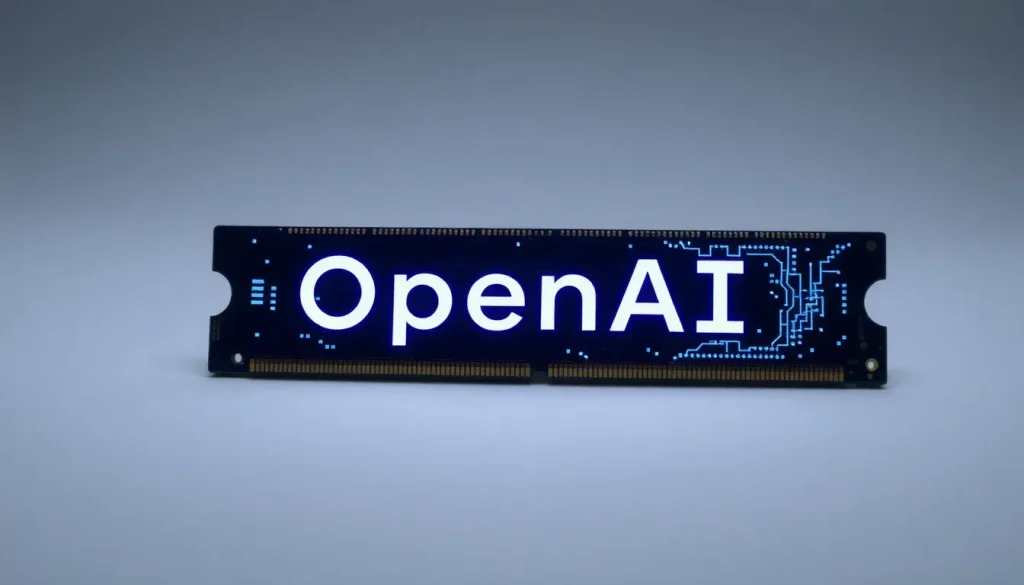OpenAI secures half of global DRAM supply in deal with Samsung and SK Hynix for Stargate AI

The technological landscape is rapidly evolving, and OpenAI has firmly positioned itself at the forefront of this transformation with its ambitious project, Stargate AI. This initiative is not just about artificial intelligence; it has far-reaching implications for the semiconductor industry and the global economy. Understanding the scale of this project and its potential impact is crucial for stakeholders across multiple sectors.
In a move that has sent shockwaves through the memory market, OpenAI has essentially secured nearly half of the world's DRAM production for the next several years. This unprecedented reservation of resources raises questions about supply dynamics and price stability within the tech industry. The stakes are incredibly high, and the ramifications will likely be felt for years to come.
- OpenAI's staggering demand for DRAM in the Stargate AI project
- The economic implications of OpenAI's DRAM reservation
- The players in the DRAM market and their stakes
- Challenges and opportunities in the memory market
- Samsung's comprehensive approach to the Stargate project
- The future of memory production and AI
OpenAI's staggering demand for DRAM in the Stargate AI project
OpenAI plans to consume an astonishing 900,000 wafers of DRAM each month until 2029. This demand translates to approximately 45% of the anticipated global production of DRAM for 2025. If the semiconductor industry fails to ramp up production to meet this demand, we could witness a significant disruption in supply, leading to skyrocketing prices and shortages for other companies relying on DRAM.
The scale of the Stargate AI project is not only unprecedented but also indicative of OpenAI's intention to dominate the artificial intelligence landscape. As Sam Altman and his team drive this initiative forward, we may be on the brink of a new era where a massive general artificial intelligence (AGI) reshapes various sectors.
The economic implications of OpenAI's DRAM reservation
The agreement with Samsung and SK Hynix has far-reaching implications for the entire semiconductor supply chain. Estimates suggest that the global capacity for DRAM will reach around 2.25 million wafers per month by the end of 2025. With OpenAI's Stargate project consuming over 40% of this capacity, other clients may face a severe shortage.
To put this into perspective, OpenAI's demand equates to approximately 1.5 to 1.7 billion chips for LPDDR5 or DDR5 memory, considering that each wafer can yield around 900 to 1,700 usable chips in a 300mm diameter wafer. Such figures are staggering and pose substantial challenges for manufacturers.
According to JP Morgan, this level of demand could represent about 130,000 billion gigabits of memory and potentially generate up to $120 billion in revenue, depending on the balance between standard DRAM and high-bandwidth memory (HBM) for AI applications. To meet this demand, investments in new factories and equipment could reach as high as $160 billion in capital expenditures.
The players in the DRAM market and their stakes
Micron, an American semiconductor giant, appears to be on the sidelines of this monumental agreement. As Samsung and SK Hynix step forward, Micron's absence could have significant implications for its future, especially in light of the increasing competition in the memory market.
For Samsung and SK Hynix, the stakes are high. While they stand to benefit financially from this deal, they also face immense pressure to meet the rigorous production demands set forth by OpenAI. Their ability to expand production capacity will be crucial in ensuring that they can fulfill their commitments while keeping prices stable for the rest of the industry.
- Samsung and SK Hynix must invest heavily in expanding their production capabilities.
- The potential for price hikes in the memory market could impact all technology sectors.
- Failure to meet demand could lead to competition for remaining memory resources.
Challenges and opportunities in the memory market
The implications of OpenAI's agreement extend beyond immediate supply concerns. As the industry grapples with the need for increased DRAM production, companies across the board will need to adapt to a new reality where memory is not just a component but a critical resource.
This shift will likely lead to:
- A renewed focus on memory technology development.
- Increased collaboration among semiconductor manufacturers to meet demand.
- Potential entry of new players into the market if existing companies cannot scale quickly enough.
Moreover, this situation presents an opportunity for companies specializing in semiconductor manufacturing equipment, such as ASML, Applied Materials, and Lam Research, as they stand to gain from increased demand for their technologies.
Samsung's comprehensive approach to the Stargate project
Samsung's involvement in the Stargate project goes beyond merely supplying memory chips. Their partnership encompasses various facets of infrastructure and design, including:
- Collaboration with Samsung SDS to design data centers that can handle the massive computational demands of Stargate AI.
- Involvement of Samsung C&T and Heavy Industries in infrastructure projects related to the initiative.
- Distribution of ChatGPT Enterprise services in Korea as part of the partnership.
However, the core focus remains on ensuring that OpenAI has uninterrupted access to the memory resources necessary for its operations. This is particularly critical as the demand for artificial intelligence services continues to surge.
The future of memory production and AI
As the demand for artificial intelligence capabilities grows, the semiconductor industry will need to scale production beyond what was previously envisioned. This challenge presents a dual-edged sword: while there is significant potential for growth, the risk of supply constraints looms large.
Should Samsung and SK Hynix fail to meet the production demands, Micron might step in to fill the gap, but this would depend on their capacity and willingness to engage in this rapidly changing landscape. The entire supply chain will need to adjust to accommodate the new realities of memory demand.
In a world where the stakes are this high, it is essential for all players involved to strategize effectively. The memory market, once seen as a stable component of the tech industry, is poised for significant upheaval. The need for DDR5 and future DDR6 memory modules may become critical, and prices will likely reflect the tension created by supply-demand dynamics.
As we move forward, it remains to be seen how the memory market will adapt. The recent agreements signal a monumental shift in the industry, and stakeholders must prepare for a landscape that could become increasingly competitive and complex.
For a deeper dive into the implications of the Stargate project and its impact on the tech industry, you can check out the following video:
This partnership sets the stage for a new chapter in technology, where memory will be at the forefront of driving innovation and progress in artificial intelligence and beyond.




Leave a Reply